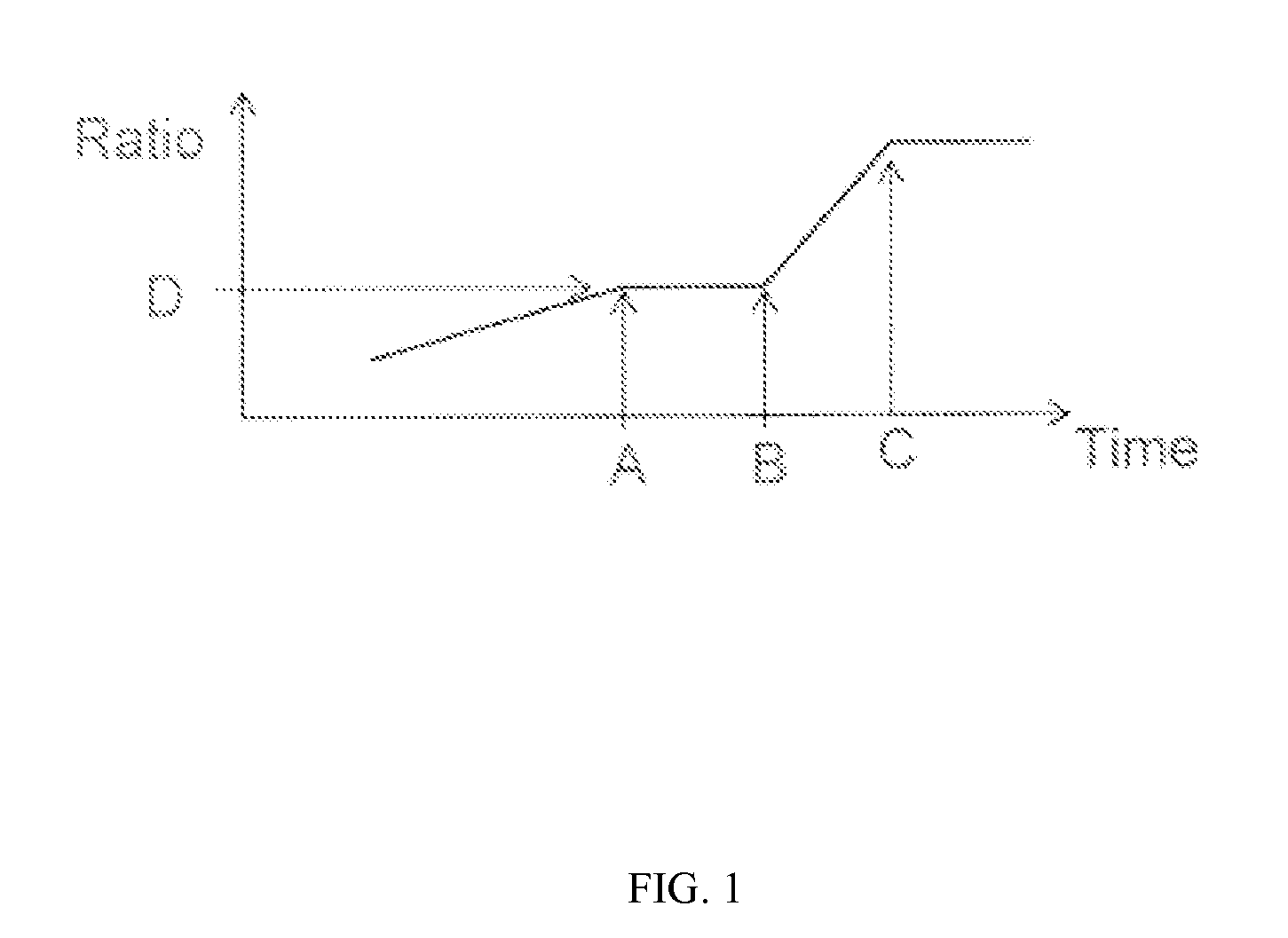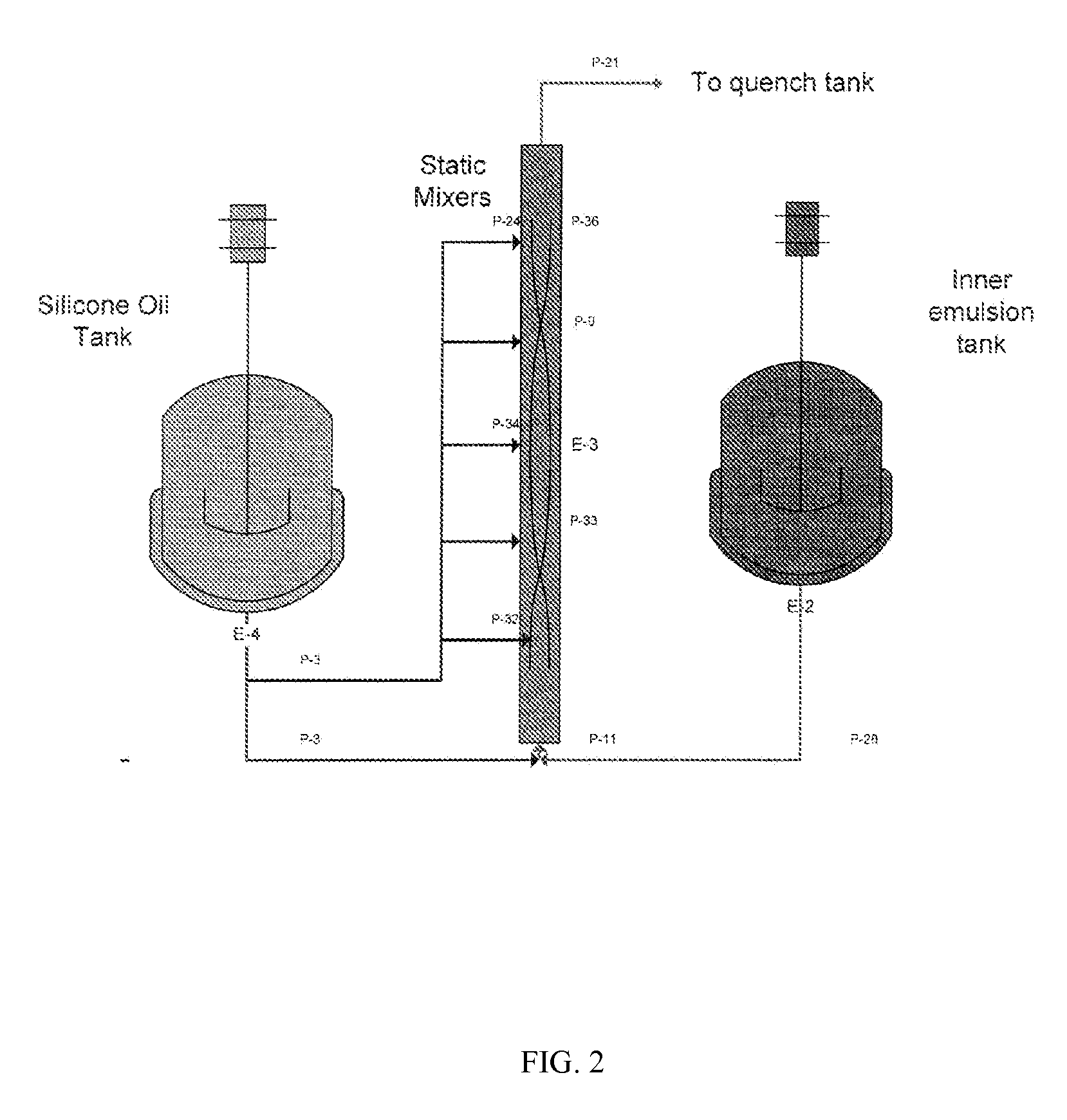Coacervation Process
a coacervation process and peptide technology, applied in the field of polypeptides, can solve the problems of low encapsulation efficiency, poor patient compliance, fluctuating levels of medicaments, etc., and achieve the effects of improving the bioavailability of incorporated medicaments, minimizing loss of activity, and excellent release profiles
- Summary
- Abstract
- Description
- Claims
- Application Information
AI Technical Summary
Benefits of technology
Problems solved by technology
Method used
Image
Examples
example 1
[0124]The effect of the profile of coacervation agent addition on residual silicone oil levels was assessed by producing placebo microparticle batches at the 105 gram and 1 kg and 15 kg scales. In addition, a 15 kg batch was produced using a spray nozzle and / or multiple addition ports to add the silicone oil to the first phase.
105 Gram Batch Size
A. Inner Water-In-Oil Emulsion Formation
[0125]A water-in-oil emulsion was created with the aid of a sonicator (Vibracell VCX 750 with a ½″ probe (part #A07109PRB; Sonics and Materials Inc., Newtown, Conn.). The water phase of the emulsion was prepared by dissolving 2.1 g sucrose in 63 g water. The oil phase of the emulsion was prepared by dissolving PLG polymer (97.7 g of purified 50:50 DL4A PLG having an internal viscosity of about 0.45 dL / g (Alkermes, Inc. in methylene chloride (1530 g or 6% w / v).
[0126]The water phase was then added to the oil phase over about a three minute period while sonicating at 100% amplitude at ambient temperature....
example 2
[0144]Microparticle batches containing exendin-4 were produced at 1 kg and 15 kg scales using a batch mode multistage coacervation process.
1 kg Batch Size
[0145]A water-in-oil emulsion was created in accordance with the 1 kg process described in Example 1 except that the water phase of the emulsion was prepared by dissolving 20 g sucrose and 50 grams exendin-4 in 600 g water for injection (WFI). Coacervation and subsequent processing steps were performed as described in Example 1. Coacervation agent was added in two distinct stages separated by a hold time as indicated in Table 2. For comparison, a reference batch was produced by adding the entire quantity of coacervation agent in a single stage. Residual silicone oil levels were determined and are listed in Table 2.
15 kg Batch Size
[0146]A water-in-oil emulsion was created in accordance with the 15 kg process described in Example 1 except that the water phase of the emulsion was prepared by dissolving 300 g sucrose and 750 grams exen...
example 3
Multi-Stage Coacervation Processes vs. Single Stage Continuous Coacervation Process
Single Stage Continuous Coacervation Process
[0148]A 6% PLG solution was prepared by dissolving 97.7 g purified 50 / 50 4A polylactide-co-glycolide (PLG) into 1530 g methylene chloride (DCM). A polypeptide solution was prepared by dissolving 2.1 g sucrose and 5.5 g bovine serum albumin (BSA) into 60 g de-ionized water. The PLG solution (organic phase) was added to the Inner Emulsion tank of the experimental apparatus shown in FIG. 7. The BSA solution (aqueous phase) was added with sonication at 100% amplitude. Sonication was continued for 2 minutes, stopped for 1 minute, and then continued for an additional 2 minutes.
[0149]The resulting inner emulsion was combined with 1000 cSt silicone oil and made to flow through a 48 inch double helical static mixer (0.5 inch diameter) at a total flow rate of 12.5 mL / sec (inner emulsion plus silicone oil). The flow rates of the inner emulsion and silicone oil pumps we...
PUM
| Property | Measurement | Unit |
|---|---|---|
| Fraction | aaaaa | aaaaa |
| Fraction | aaaaa | aaaaa |
| Fraction | aaaaa | aaaaa |
Abstract
Description
Claims
Application Information
 Login to View More
Login to View More - R&D
- Intellectual Property
- Life Sciences
- Materials
- Tech Scout
- Unparalleled Data Quality
- Higher Quality Content
- 60% Fewer Hallucinations
Browse by: Latest US Patents, China's latest patents, Technical Efficacy Thesaurus, Application Domain, Technology Topic, Popular Technical Reports.
© 2025 PatSnap. All rights reserved.Legal|Privacy policy|Modern Slavery Act Transparency Statement|Sitemap|About US| Contact US: help@patsnap.com



